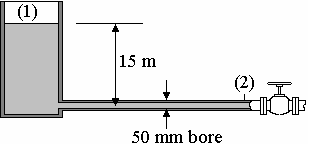Reference no: EM13924392
Assignment- FLUID MECHANICS
Q.1. All fluids in Fig.1 are at 20μC. If p = 1900 psf at point A, determine the pressures at B, C, and D in psf.
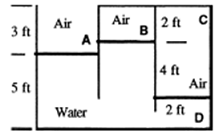
Figure.1
Q.2. In Fig.2 the pressure at point Ais 25 psi. All fluids are at 20μC. What is the air pressure in the closed chamber B?
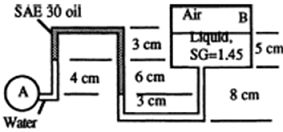
Figure 2
Q.3. In some wind tunnels the test section is perforated to suck out fluid and provide a thin viscous boundary layer. The test section wall in Fig.3 contains 1200 holes of 5-mm diameter each per square meter of wall area. The suction velocity through each hole is Vr = 8 m/s, and the test-section entrance velocity is V1 = 35 m/s. Assuming incompressible steady flow of air at 20°C, compute (a) Vo, (b) V2, and (c) Vf, in m/s
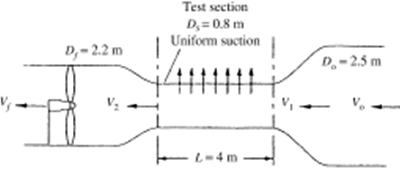
Q.4. The power required to drive a centrifugal pump and the pressure that the pump will develop depend upon the size (diameter) and speed (angular velocity) of the impeller, the volumetric flow rate through the pump, and the fluid properties. However, if the fluid is not too viscous (e.g. less than about 100 cP), the pump performance is essentially independent of the fluid viscosity. Under these conditions:
Perform a dimensional analysis to determine the dimensionless groups that would be required to define the pump performance. Arrange the groups so that the power and pump pressure each appear in only one group. ( Use Buckingham-Pi Theroem)
Q.5. In the orifice meter, a flat disk with a central opening of diameter Do is set across a pipe of diameter D, and the pressure drop ΔP across the opening is measured. It is postulated that ΔP is a function of the average fluid velocity in the pipe V, the density of the fluid ρ, the fluid viscosity µ, and the diameters of the pipe and the opening, D and Do respectively. Thus
ΔP = function (V, ρ, µ, D, Do)
Find an acceptable set of dimensionless groups which relate these various factors.
Q.6. Water at 20 deg.C is pumped at a constant rate of 9 m3/hr from a large reservoir resting on the floor to the open top of an experimental absorption tower. The point of discharge is 5 m above the floor, and the friction losses in the 5 mm pipe from the reservoir to the tower amount to 2.5 J/Kg. At what height in the reservoir must the water level be kept if the pump can deliver only 0.1 kW?
Density of water = 998 kg/m3
Q.7. A horizontal venture meter having a throat diameter of 20 mm is set in a 75 mm ID pipeline. Water at 15 deg.C is flowing through the line. A manometer containing mercury under water measures the pressure differential over the instrument. When the manometer reading is 500 m, what is the flow rate in m3/hr. If 12 % of the differential is permanently lost, what is the power consumption of the meter?
Assume, coefficient of venturi, Cv = 0.98 , density of water = 999 kg/m3
Q.8. A research submarine is designed to operate 3 km below the ocean surface. If then interior pressure is 1 atm, what is the total pressure on a 15cm diameter window and force on window.
The average density of seawater is 1028 kg/m3
Q.9. The diagram shows a pump delivering water through a pipe 30 mm bore to a tank. Find the pressure at point (1) when the flow rate is 1.4 dm3/sec. The density of water is 1000 kg/m3 . The loss of pressure due to friction is 50 KPa.
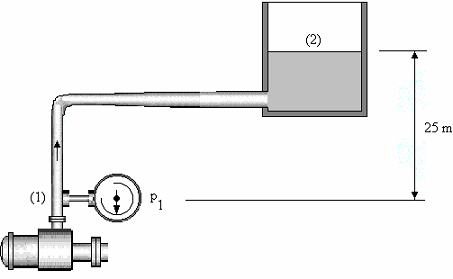
Q.10. The diagram shows a tank that is drained by a horizontal pipe. Calculate the pressure head at point (2) when the valve is partially closed so that the flow rate is reduced to 20 dm3/sec. The pressure loss is 2 m head.
